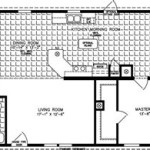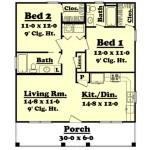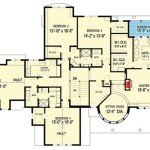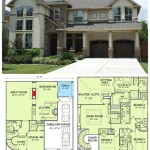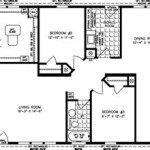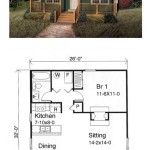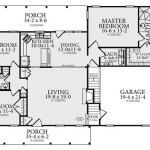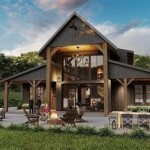One-Level Ranch House Plans: Exploring Comfort, Accessibility, and Design
One-level ranch house plans represent a popular architectural style known for its horizontal layout, ease of access, and often, its mid-century modern influences. These plans are appealing to a wide range of homeowners, from those seeking aging-in-place solutions to families desiring open-concept living. The inherent simplicity of a ranch-style home lends itself to customization, making it possible to adapt standard plans to specific needs and preferences.
The defining characteristic of a one-level ranch is its single-story construction. This eliminates the need for stairs, contributing to its accessibility and safety. The absence of vertical separation also fosters a sense of connection throughout the home, often enhanced by open living spaces. Ranch homes are typically characterized by a low-pitched roof, wide eaves, and large windows that often integrate indoor and outdoor living spaces.
The historical origins of the ranch house can be traced back to the 1930s, gaining significant popularity in the post-World War II era. Its design was originally inspired by Spanish Colonial architecture, emphasizing functionality and a connection to the landscape. The rise of suburban development after the war fueled the demand for affordable and easily constructed housing, making the ranch style a perfect fit. Through the years, the style has evolved, incorporating contemporary design elements while retaining its fundamental characteristics.
Key Advantages of One-Level Ranch House Plans
One-level ranch house plans offer numerous advantages that contribute to their enduring popularity. These benefits range from practical considerations like accessibility to lifestyle factors such as ease of maintenance and design flexibility.
Accessibility and Aging in Place: Perhaps the most significant advantage is the inherent accessibility of a single-story home. With no stairs, ranch homes are ideal for individuals with mobility challenges, families with young children, and those planning to age in place. The level floor plan reduces the risk of falls and allows for easy navigation throughout the house. Many ranch house plans can be further adapted to enhance accessibility, including wider doorways, roll-in showers, and grab bars in bathrooms.
Ease of Maintenance and Cleaning: The absence of stairs simplifies home maintenance tasks, such as cleaning and repairs. Carrying heavy items or cleaning windows becomes significantly easier on a single level. Similarly, exterior maintenance, such as gutter cleaning and roof repairs, is often less challenging on a ranch home due to its lower height. This can translate to lower maintenance costs over the lifespan of the home.
Open Concept Living and Design Flexibility: Ranch house plans often lend themselves to open-concept living areas, creating a spacious and airy atmosphere. The absence of supporting walls enables greater flexibility in interior design and layout. This allows homeowners to customize the floor plan to suit their specific needs, such as creating a large family room or a combined kitchen and dining area. Ranch plans can also be easily expanded horizontally, providing the option to add rooms or wings as needed.
Factors to Consider When Choosing a Ranch House Plan
Selecting the right ranch house plan requires careful consideration of various factors, including lot size, budget, lifestyle, and long-term needs. Understanding these factors will help ensure that the chosen plan meets the homeowner’s requirements and provides a comfortable and functional living space.
Lot Size and Orientation: Ranch homes typically require a larger lot than multi-story houses due to their horizontal footprint. It's crucial to assess the lot size and shape to ensure that the chosen plan fits comfortably within the property boundaries. The orientation of the house on the lot is also important for maximizing natural light and energy efficiency. Consider the position of the sun throughout the day and how it will affect the interior spaces. Furthermore, the placement of windows and outdoor living areas should take into account privacy and views.
Budget and Construction Costs: While ranch homes are often perceived as being more affordable to build than multi-story houses, construction costs can vary depending on the size, materials, and finishes. It's essential to establish a realistic budget and obtain quotes from multiple builders before committing to a plan. Factors that can impact construction costs include the complexity of the foundation, the type of roofing materials, and the level of customization.
Lifestyle and Family Needs: The chosen ranch house plan should align with the homeowner's lifestyle and family needs. Consider the number of bedrooms and bathrooms required, the size of the living areas, and the presence of any specialized spaces, such as a home office or a playroom. Think about how the space will be used on a daily basis and whether it meets the family's long-term needs. For example, if the family anticipates future growth, it may be wise to choose a plan that allows for easy expansion.
Essential Elements of Effective Ranch House Plans
Certain elements consistently contribute to the success and practicality of one-level ranch house plans. These encompass structural considerations, interior design principles, and energy efficiency measures.
Efficient Layout and Flow: An effective ranch house plan prioritizes an efficient layout and a seamless flow between rooms. The living areas should be easily accessible from the bedrooms and bathrooms, and the kitchen should be conveniently located near the dining area. Hallways should be wide and uncluttered to facilitate movement. Thoughtful consideration should be given to the placement of doors and windows to maximize natural light and ventilation.
Adequate Storage Space: Storage is a critical component of any well-designed home, and ranch houses are no exception. Adequate closet space, pantry space, and garage storage are essential for maintaining an organized and uncluttered living environment. Consider incorporating built-in storage solutions, such as bookshelves and cabinets, to maximize space efficiency. Attics and crawl spaces can also be utilized for additional storage, but access should be carefully planned.
Energy Efficiency and Sustainability: Energy efficiency is an increasingly important consideration in home design. Ranch houses can be designed to be highly energy-efficient by incorporating features such as energy-efficient windows and doors, proper insulation, and high-efficiency heating and cooling systems. Consider using sustainable building materials and incorporating renewable energy sources, such as solar panels, to minimize environmental impact. Proper landscaping can also contribute to energy efficiency by providing shade and reducing heat gain.
Modern ranch designs often incorporate larger windows and sliding glass doors that connect the interior spaces to outdoor living areas, like patios and decks. This blurring of the lines between inside and out enhances the feeling of spaciousness and allows homeowners to enjoy their surroundings. The exterior materials used in ranch homes are also often chosen for their durability and low maintenance requirements, contributing to the overall value and longevity of the property.
Many ranch house plans include attached garages, providing convenient access to vehicles and additional storage space. The garage can be integrated seamlessly into the overall design of the house, enhancing its curb appeal and functionality. Some plans also incorporate mudrooms or entryways that provide a transition space between the garage and the main living areas.
The adaptability of ranch house plans makes them suitable for a wide range of locations, from urban settings to rural landscapes. They can be easily adapted to different climates and terrains. In warmer climates, ranch homes are often designed with large porches and patios to provide shaded outdoor living spaces. In colder climates, they can be easily insulated to minimize heat loss and reduce energy consumption.
Renovating a ranch house can also be a straightforward process due to its simple construction. Walls can often be reconfigured to create more open living spaces, and additions can be added to expand the footprint of the house. This flexibility makes ranch homes a popular choice for homeowners who want to customize their living space over time.
In conclusion, the appeal of one-level ranch house plans lies in their combination of practicality, accessibility, and design flexibility. By carefully considering the various factors involved in choosing a plan and incorporating essential design elements, homeowners can create a comfortable, functional, and sustainable living space that meets their specific needs and preferences.

House Plan 45467 Ranch Style With 1680 Sq Ft 4 Bed 2 Bath

Ranch House Plans Floor Cool

Ranch Style House Plans

Ranch Home Plans By Design Basics

1st Story Ranch Floor Plan Bing

Trending Ranch Style House Plans With Open Floor Blog Eplans Com

Ranch House Plans American Design Style Home

House Plan 75171 Ranch Style With 2486 Sq Ft 3 Bed 2 Bath 1

One Story House Plans

Ranch House Plans Rambler Floor Rancher Designs Houseplans Com

